On This Page:
Intelligence in psychology refers to the mental capacity to learn from experiences, adapt to new situations, understand and handle abstract concepts, and use knowledge to manipulate one’s environment. It includes skills such as problem-solving, critical thinking, learning quickly, and understanding complex ideas.
Key Takeaways
- Defining and classifying intelligence is extremely complicated. Theories of intelligence range from having one general intelligence (g) to certain primary mental abilities and multiple category-specific intelligences.
- Following the creation of the Binet-Simon scale in the early 1900s, intelligence tests, now referred to as intelligence quotient (IQ) tests, are the most widely-known and used measure for determining an individual’s intelligence.
- Although these tests are generally reliable and valid tools, they have flaws as they lack cultural specificity and can evoke stereotype threats and self-fulfilling prophecies.
- IQ scores are normally distributed, meaning that 95% of the population has IQ scores between 70 and 130. However, some extreme examples exist of people with scores far exceeding 130 or far below 70.

What Is Intelligence?
It might seem useless to define such a simple word. After all, we have all heard this word hundreds of times and probably have a general understanding of its meaning.
However, the concept of intelligence has been a widely debated topic among members of the psychology community for decades.
Intelligence has been defined in many ways: higher level abilities (such as abstract reasoning, mental representation, problem solving, and decision making), the ability to learn, emotional knowledge, creativity, and adaptation to meet the demands of the environment effectively.
Psychologist Robert Sternberg defined intelligence as “the mental abilities necessary for adaptation to, as well as shaping and selection of, any environmental context (1997, p. 1).
History of Intelligence
The study of human intelligence dates back to the late 1800s when Sir Francis Galton (the cousin of Charles Darwin) became one of the first to study intelligence.
Galton was interested in the concept of a gifted individual, so he created a lab to measure reaction times and other physical characteristics to test his hypothesis that intelligence is a general mental ability producing biological evolution (hello, Darwin!).
Galton theorized that because quickness and other physical attributes were evolutionarily advantageous, they would also provide a good indication of general mental ability (Jensen, 1982).
Thus, Galton operationalized intelligence as reaction time.
Operationalization is an important process in research that involves defining an unmeasurable phenomenon (such as intelligence) in measurable terms (such as reaction time), allowing the concept to be studied empirically (Crowthre-Heyck, 2005).
Galton’s study of intelligence in the laboratory setting and his theorization of the heritability of intelligence paved the way for decades of future research and debate in this field.
Theories of Intelligence
Some researchers argue that intelligence is a general ability, whereas others make the assertion that intelligence comprises specific skills and talents. Psychologists contend that intelligence is genetic, or inherited, and others claim that it is largely influenced by the surrounding environment.
As a result, psychologists have developed several contrasting theories of intelligence as well as individual tests that attempt to measure this very concept.
Spearman’s General Intelligence (g)
General intelligence, also known as g factor, refers to a general mental ability that, according to Spearman, underlies multiple specific skills, including verbal, spatial, numerical, and mechanical.
Charles Spearman, an English psychologist, established the two-factor theory of intelligence back in 1904 (Spearman, 1904). To arrive at this theory, Spearman used a technique known as factor analysis.
Factor analysis is a procedure through which the correlation of related variables is evaluated to find an underlying factor that explains this correlation.
In the case of intelligence, Spearman noticed that those who did well in one area of intelligence tests (for example, mathematics) also did well in other areas (such as distinguishing pitch; Kalat, 2014).
In other words, there was a strong correlation between performing well in math and music, and Spearman then attributed this relationship to a central factor, that of general intelligence (g).
Spearman concluded that there is a single g-factor that represents an individual’s general intelligence across multiple abilities and that a second factor, s, refers to an individual’s specific ability in one particular area (Spearman, as cited in Thomson, 1947).
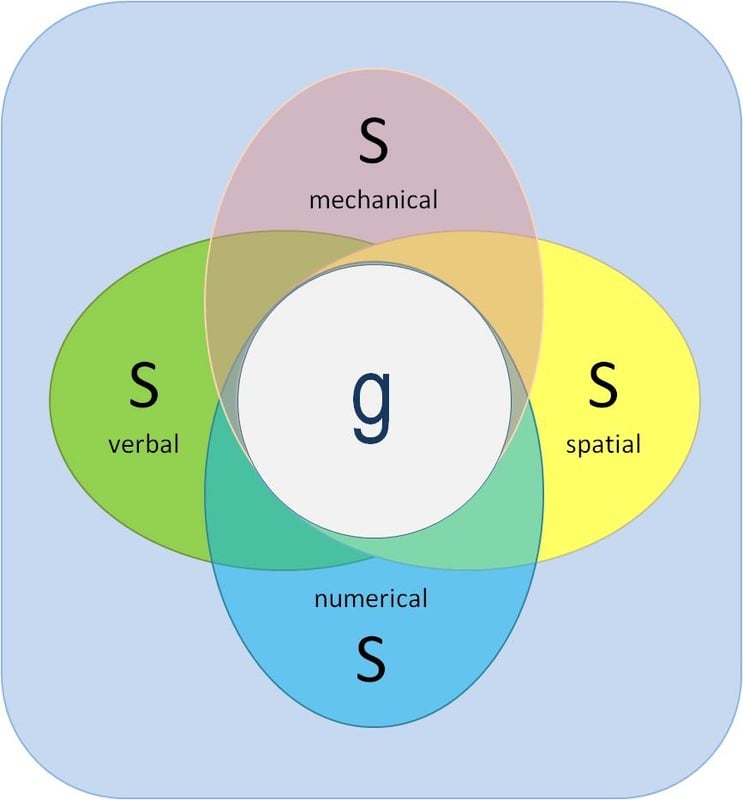
Together, these two main factors compose Spearman’s two-factor theory.
Thurstone’s Primary Mental Abilities
Thurstone (1938) challenged the concept of a g-factor. After analyzing data from 56 different tests of mental abilities, he identified a number of primary mental abilities that comprise intelligence as opposed to one general factor.
The seven primary mental abilities in Thurstone’s model are verbal comprehension, verbal fluency, number facility, spatial visualization, perceptual speed, memory, and inductive reasoning (Thurstone, as cited in Sternberg, 2003).
| Mental Ability | Description |
|---|---|
| Word Fluency | Ability to use words quickly and fluency in performing such tasks as rhyming, solving anagrams, and doing crossword puzzles. |
| Verbal Comprehension | Ability to understand the meaning of words, concepts, and ideas. |
| Numerical Ability | Ability to use numbers to quickly compute answers to problems. |
| Spatial Visualization | Ability to visualize and manipulate patterns and forms in space. |
| Perceptual Speed | Ability to grasp perceptual details quickly and accurately and to determine similarities and differences between stimuli. |
| Memory | Ability to recall information such as lists or words, mathematical formulas, and definitions. |
| Inductive Reasoning | Ability to derive general rules and principles from the presented information. |
Although Thurstone did not reject Spearman’s idea of general intelligence altogether, he instead theorized that intelligence consists of both general ability and a number of specific abilities, paving the way for future research that examined the different forms of intelligence.
Gardner’s Multiple Intelligences
Following the work of Thurstone, American psychologist Howard Gardner built off the idea that there are multiple forms of intelligence.
He proposed that there is no single intelligence, but rather distinct, independent multiple intelligences exist, each representing unique skills and talents relevant to a certain category.
Gardner (1983, 1987) initially proposed seven multiple intelligences: linguistic, logical-mathematical, spatial, musical, bodily-kinesthetic, interpersonal, and intrapersonal, and he has since added naturalist intelligence.
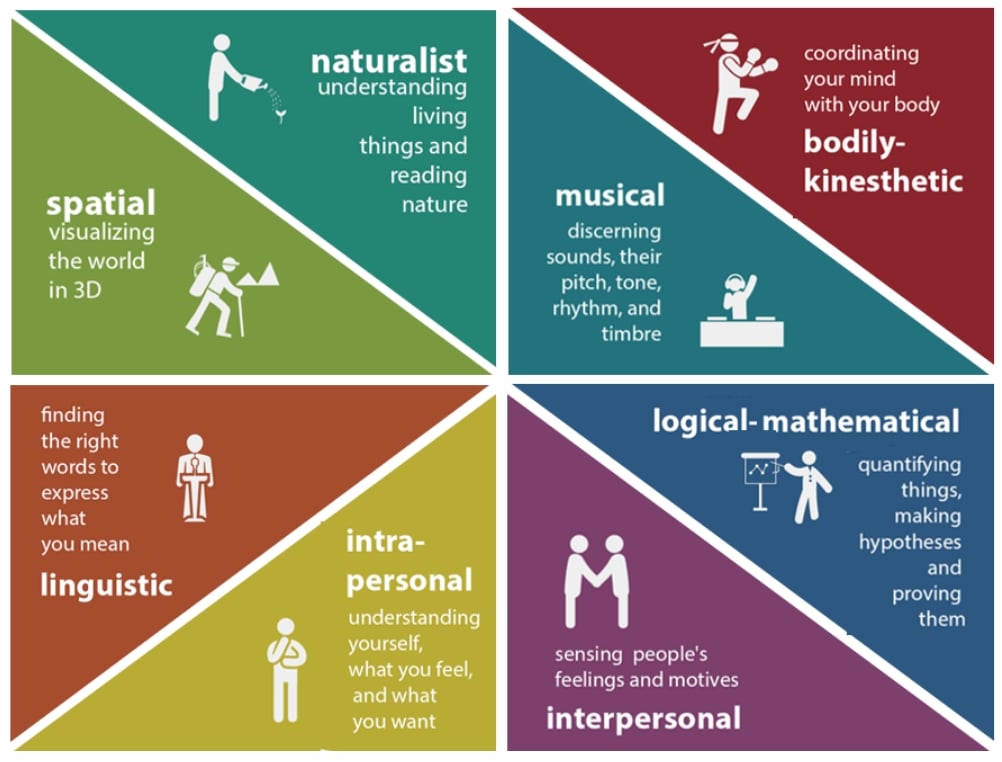
Gardner holds that most activities (such as dancing) will involve a combination of these multiple intelligences (such as spatial and bodily-kinesthetic intelligences). He also suggests that these multiple intelligences can help us understand concepts beyond intelligence, such as creativity and leadership.
And although this theory has widely captured the attention of the psychology community and the greater public, it does have its faults.
There have been few empirical studies that actually test this theory, and this theory does not account for other types of intelligence beyond the ones Gardner lists (Sternberg, 2003).
Triarchic Theory of Intelligence
Just two years later, in 1985, Robert Sternberg proposed a three-category theory of intelligence, integrating components that were lacking in Gardner’s theory. This theory is based on the definition of intelligence as the ability to achieve success based on your personal standards and your sociocultural context.
According to the triarchic theory, intelligence has three aspects: analytical, creative, and practical (Sternberg, 1985).
Analytical intelligence, also referred to as componential intelligence, refers to intelligence that is applied to analyze or evaluate problems and arrive at solutions. This is what a traditional IQ test measures.
Creative intelligence is the ability to go beyond what is given to create novel and interesting ideas. This type of intelligence involves imagination, innovation, and problem-solving.
Practical intelligence is the ability that individuals use to solve problems faced in daily life when a person finds the best fit between themselves and the demands of the environment.
Adapting to the demands environment involves either utilizing knowledge gained from experience to purposefully change oneself to suit the environment (adaptation), changing the environment to suit oneself (shaping), or finding a new environment in which to work (selection).
Other Types of Intelligence
After examining the popular competing theories of intelligence, it becomes clear that there are many different forms of this seemingly simple concept.
On the one hand, Spearman claims that intelligence is generalizable across many different areas of life, and on the other hand, psychologists such as Thurstone, Gardener, and Sternberg hold that intelligence is like a tree with many different branches, each representing a specific form of intelligence.
To make matters even more interesting, let’s throw a few more types of intelligence into the mix!
Emotional Intelligence
Emotional Intelligence is the “ability to monitor one’s own and other people’s emotions, to discriminate between different emotions and label them appropriately, and to use emotional information to guide thinking and behavior” (Salovey and Mayer, 1990).
Emotional intelligence is important in our everyday lives, seeing as we experience one emotion or another nearly every second of our lives. You may not associate emotions and intelligence with one another, but in reality, they are very related.
Emotional intelligence refers to the ability to recognize the meanings of emotions and to reason and problem-solve on the basis of them (Mayer, Caruso, & Salovey, 1999). The four key components of emotional Intelligence are (i) self-awareness, (ii) self-management, (iii) social awareness, and (iv) relationship management.
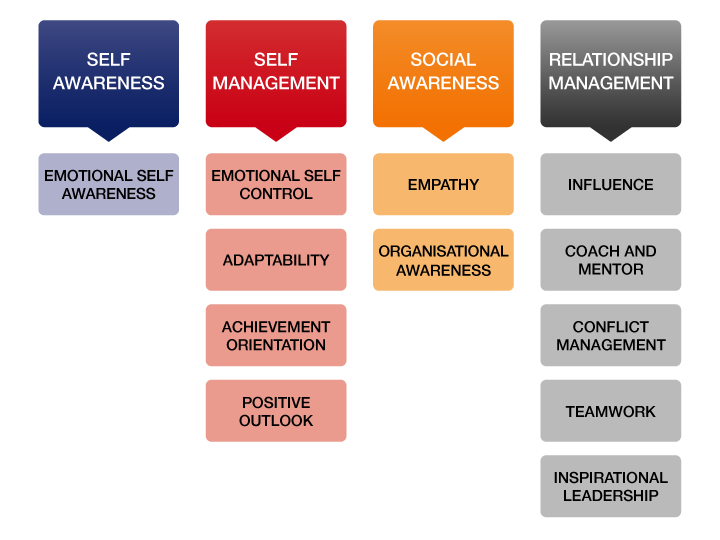
In other words, if you are high in emotional intelligence, you can accurately perceive emotions in yourself and others (such as reading facial expressions), use emotions to help facilitate thinking, understand the meaning behind your emotions (why are you feeling this way?), and know how to manage your emotions (Salovey & Mayer, 1990).
Fluid vs. Crystallized Intelligence
Raymond Cattell (1963) first proposed the concepts of fluid and crystallized intelligence and further developed the theory with John Horn.
Fluid intelligence is the ability to problem solve in novel situations without referencing prior knowledge, but rather through the use of logic and abstract thinking. Fluid intelligence can be applied to any novel problem because no specific prior knowledge is required (Cattell, 1963). As you grow older fluid increases and then starts to decrease in the late 20s.
Crystallized intelligence refers to the use of previously-acquired knowledge, such as specific facts learned in school or specific motor skills or muscle memory (Cattell, 1963). As you grow older and accumulate knowledge, crystallized intelligence increases.
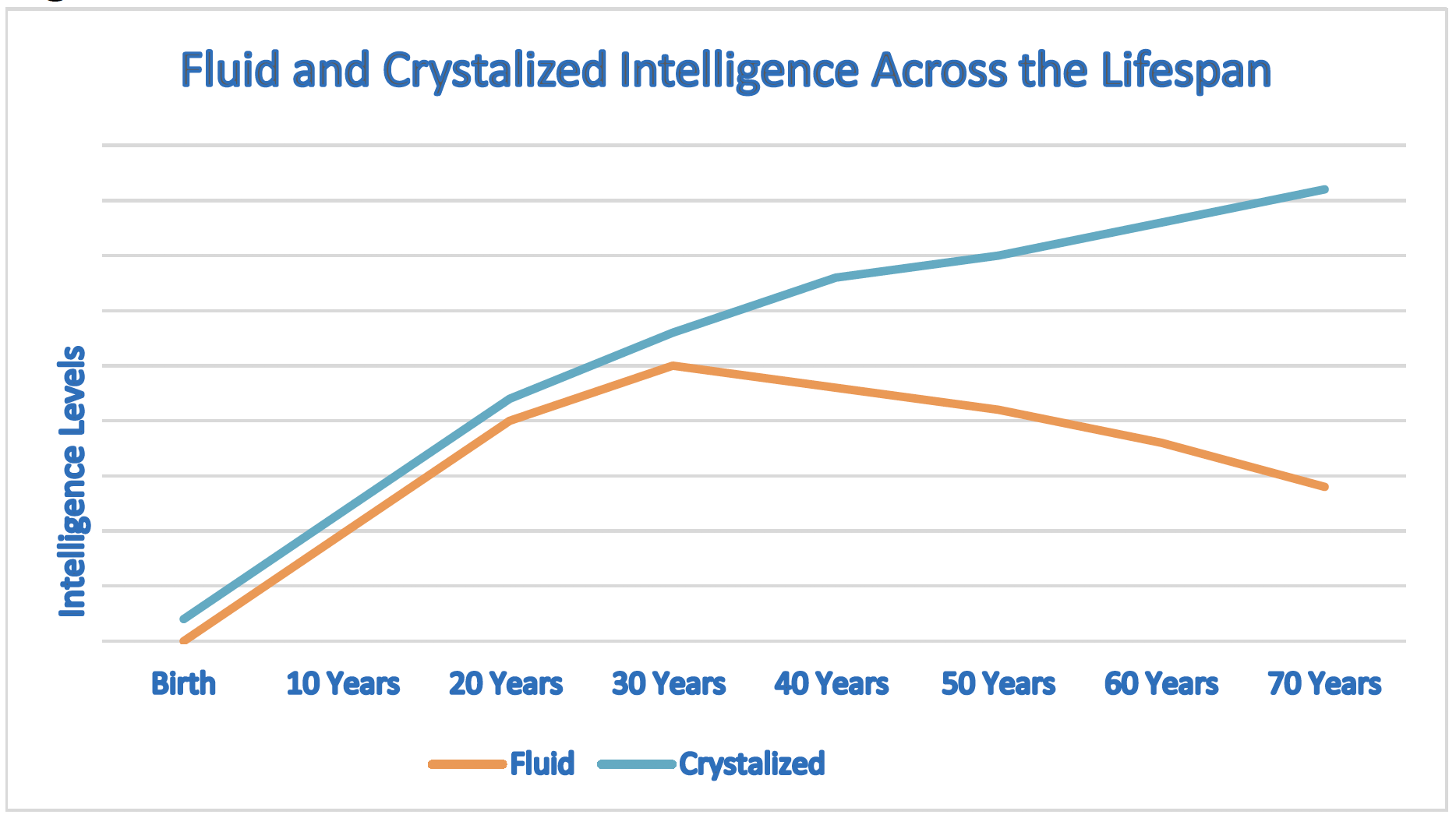
The Cattell-Horn (1966) theory of fluid and crystallized intelligence suggests that intelligence is composed of a number of different abilities that interact and work together to produce overall individual intelligence.
For example, if you are taking a hard math test, you rely on your crystallized intelligence to process the numbers and meaning of the questions, but you may use fluid intelligence to work through the novel problem and arrive at the correct solution. It is also possible that fluid intelligence can become crystallized intelligence.
The novel solutions you create when relying on fluid intelligence can, over time, develop into crystallized intelligence after they are incorporated into long-term memory.
This illustrates some of the ways in which different forms of intelligence overlap and interact with one another, revealing its dynamic nature.
Intelligence Testing
Binet-Simon Scale
During the early 1900s, the French government enlisted the help of psychologist Alfred Binet to understand which children were going to be slower learners and thus required more assistance in the classroom (Binet et al., 1912).
As a result, he and his colleague, Theodore Simon, began to develop a specific set of questions that focused on areas such as memory and problem-solving skills.
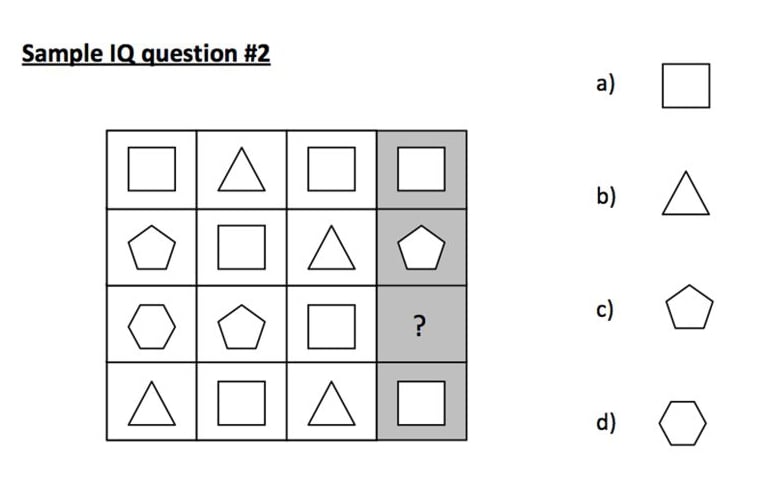
They tested these questions on groups of students aged three to twelve to help standardize the measure (Binet et al., 1912). Binet realized that some children were able to answer advanced questions that their older peers were able to answer.
As a result, he created the concept of mental age, or how well an individual performs intellectually relative to the average performance at that age (Cherry, 2020).
Ultimately, Binet finalized the scale, known as the Binet-Simon scale, that became the basis for the intelligence tests still used today.
The Binet-Simon scale of 1905 comprised 30 items designed to measure judgment, comprehension, and reasoning, which Binet deemed the key characteristics of intelligence.
Stanford-Binet Intelligence Scale
When the Binet-Simon scale made its way over to the United States, Stanford psychologist Lewis Terman adapted the test for American students and published the Stanford-Binet Intelligence Scale in 1916 (Cherry, 2020).
The Stanford-Binet Scale is a contemporary assessment that measures intelligence according to five features of cognitive ability,
including fluid reasoning, knowledge, quantitative reasoning, visual-spatial processing, and working memory. Both verbal and nonverbal responses are measured.
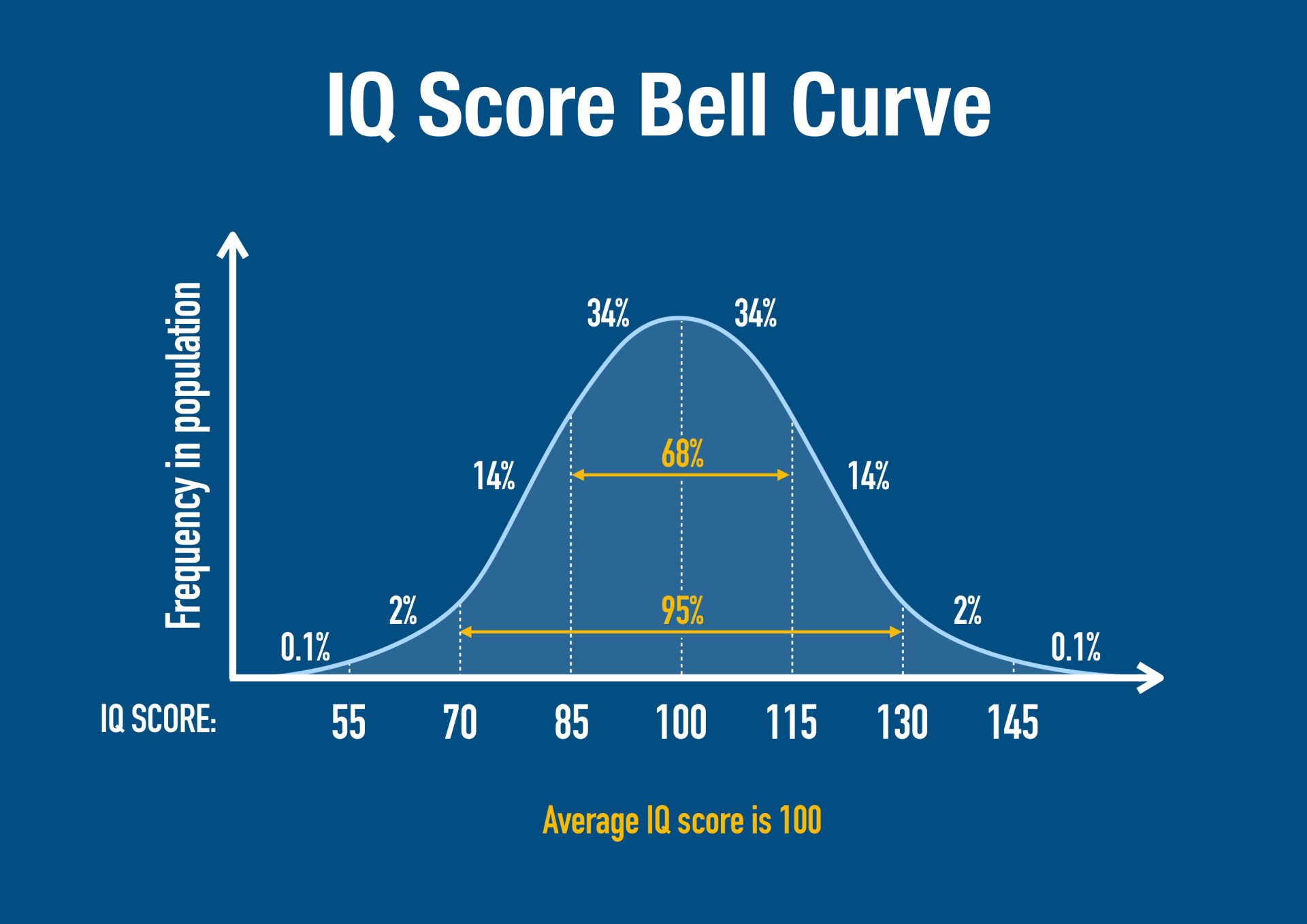
This test used a single number, referred to as the intelligence quotient (IQ), to indicate an individual’s score.
The average score for the test is 100, and any score from 90 to 109 is considered to be in the average intelligence range. Scores from 110 to 119 are considered to be High Average. Superior scores range from 120 to 129 and anything over 130 is considered Very Superior.
To calculate IQ, the student’s mental age is divided by his or her actual (or chronological) age, and this result is multiplied by 100. If your mental age is equal to your chronological age, you will have an IQ of 100, or average. If your mental age is 12, but your chronological age is only 10, you will have an above-average IQ of 120.
WISC and WAIS
Just as theories of intelligence build off one another, intelligence tests do too. After Terman created Stanford-Binet test, American psychologist David Wechsler developed a new tool due to his dissatisfaction with the limitations of the Stanford-Binet test (Cherry, 2020).
Like Thurstone, Gardner, and Sternberg, Wechsler believed intelligence involved many different mental abilities and felt that the Stanford-Binet scale too closely reflected the idea of one general intelligence.
Because of this, Wechsler created the Wechsler Intelligence Scale for Children (WISC) and the Wechsler Adult Intelligence Scale (WAIS) in 1955, with the most up-to-date version being the WAIS-IV (Cherry, 2020).
The Wechsler Intelligence Scale for Children (WISC), developed by David Wechsler, is an IQ test designed to measure intelligence and cognitive ability in children between the ages of 6 and 16. It is currently in its fourth edition (WISC-V) released in 2014 by Pearson.
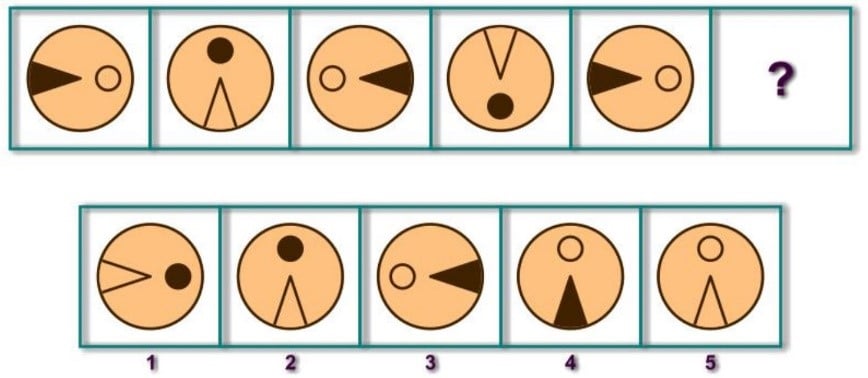
Above Image: WISC-IV Sample Test Question
The Wechsler Adult Intelligence Scale (WAIS) is an IQ test designed to measure cognitive ability in adults and older adolescents, including
verbal comprehension, perceptual reasoning, working memory, and processing speed.
The latest version of the Wechsler Adult Intelligence Scale (WAIS-IV) was standardized on 2,200 healthy people between the ages of 16 and 90 years (Brooks et al., 2011).
The standardization of a test involves giving it to a large number of people of different ages to compute the average score on the test at each age level.
The overall IQ score combines the test takers’ performance in all four categories (Cherry, 2020). And rather than calculating this number based on mental and chronological age, the WAIS compares the individual’s score to the average score at that level, as calculated by the standardization process.
The Flynn Effect
It is important to regularly standardize an intelligence test because the overall level of intelligence in a population may change over time.
This phenomenon is known as the Flynn effect (named after its discoverer, New Zealand researcher James Flynn) which refers to the observation that scores on intelligence tests worldwide increase from decade to decade (Flynn, 1984).
Aptitude vs. Achievement Tests
Other tests, such as aptitude and achievement tests, are designed to measure intellectual capability. Achievement tests measure what content a student has already learned (such as a unit test in history or a final math exam), whereas an aptitude test measures a student’s potential or ability to learn (Anastasi, 1984).
Although this may sound similar to an IQ test, aptitude tests typically measure abilities in very specific areas.
Criticism of Intelligence Testing
Criticisms have ranged from the claim that IQ tests are biased in favor of white, middle-class people. Negative stereotypes about a person’s ethnicity, gender, or age may cause the person to suffer stereotype threat, a burden of doubt about his or her own abilities, which can create anxiety that result in lower scores.
Reliability and Construct Validity
Although you may be wondering if you take an intelligence test multiple times will you improve your score and whether these tests even measure intelligence in the first place, research provides reassurance that these tests are both very reliable and have high construct validity.
Reliability simply means that they are consistent over time. In other words, if you take a test at two different points in time, there will be very little change in performance or, in the case of intelligence tests, IQ scores.
Although this isn’t a perfect science, and your score might slightly fluctuate when taking the same test on different occasions or different tests at the same age, IQ tests demonstrate relatively high reliability (Tuma & Appelbaum, 1980).
Additionally, intelligence tests also reveal strong construct validity, meaning that they are, in fact, measuring intelligence rather than something else.
Researchers have spent hours on end developing, standardizing, and adapting these tests to best fit the current times. But that is also not to say that these tests are completely flawless.
Research documents errors with the specific scoring of tests and interpretation of the multiple scores (since typically, an individual will receive an overall IQ score accompanied by several category-specific scores), and some studies question the actual validity, reliability, and utility for individual clinical use of these tests (Canivez, 2013).
Additionally, intelligence scores are created to reflect different theories of intelligence, so the interpretations may be heavily based on the theory upon which the test is based (Canivez, 2013).
Cultural Specificity
There are issues with intelligence tests beyond looking at them in a vacuum. These tests were created by Western psychologists who created such tools to measure euro-centric values.
But it is important to recognize that the majority of the world’s population does not reside in Europe or North America, and as a result, the cultural specificity of these tests is crucial.
Different cultures hold different values and even have different perceptions of intelligence, so is it fair to have one universal marker of this increasingly complex concept?
For example, a 1992 study found that Kenyan parents defined intelligence as the ability to do without being told what needed to be done around the homestead (Harkness et al., 1992), and, given the American and European emphasis on speed, some Ugandans define intelligent people as being slow in thought and action (Wober, 1974).
Together, these examples illustrate the flexibility of defining intelligence, making capturing this concept in a single test, let alone a single number even more challenging. And even within the U.S., do perceptions of intelligence differ?
An example is in San Jose, California, where Latino, Asian, and Anglo parents had varying definitions of intelligence. The teachers’ understanding of intelligence was more similar to that of the Asian and Anglo communities, and this similarity predicted the child’s performance in school (Okagaki & Sternberg, 1993).
That is, students whose families had more similar understandings of intelligence were doing better in the classroom.
Intelligence takes many forms, ranging from country to country and culture to culture. Although IQ tests might have high reliability and validity, understanding the role of culture is as, if not more, important in forming the bigger picture of an individual’s intelligence.
IQ tests may accurately measure academic intelligence, but more research must be done to discern whether they truly measure practical intelligence or even just general intelligence in all cultures.
Social and Environmental Factors
Another important part of the puzzle to consider is the social and environmental context in which an individual lives and the IQ test-related biases that develop as a result.
These might help explain why some individuals have lower scores than others. For example, the threat of social exclusion can greatly decrease the expression of intelligence.
A 2002 study gave participants an IQ test and a personality inventory, and some were randomly chosen to receive feedback from the inventory indicating that they were “the sort of people who would end up alone in life” (Baumeister et al., 2002).
After a second test, those who were told they would be loveless and friendless in the future answered significantly fewer questions than they did on the earlier test.
And these findings can translate into the real world where not only the threat of social exclusion can decrease the expression of intelligence but also a perceived threat to physical safety.
In other words, a child’s poor academic performance can be attributed to the disadvantaged, potentially unsafe communities in which they grow up.
Stereotype Threat
Stereotype threat is a phenomenon in which people feel at risk of conforming to stereotypes about their social group. Negative stereotypes can also create anxiety that results in lower scores.
In one study, Black and White college students were given part of the verbal section from the Graduate Record Exam (GRE), but in the stereotype threat condition, they told students the test diagnosed intellectual ability, thus potentially making the stereotype that Blacks are less intelligent than Whites salient.
The results of this study revealed that in the stereotype threat condition, Blacks performed worse than Whites, but in the no stereotype threat condition, Blacks and Whites performed equally well (Steele & Aronson, 1995).
And even just recording your race can also result in worsened performance. Stereotype threat is a real threat and can be detrimental to an individual’s performance on these tests.
Self-Fulfilling Prophecy
Stereotype threat is closely related to the concept of a self-fulfilling prophecy in which an individual’s expectations about another person can result in the other person acting in ways that conform to that very expectation.
In one experiment, students in a California elementary school were given an IQ test, after which their teachers were given the names of students who would become “intellectual bloomers” that year based on the results of the test (Rosenthal & Jacobson, 1968).
At the end of the study, the students were tested again with the same IQ test, and those labeled as “intellectual bloomers” significantly increased their scores.
This illustrates that teachers may subconsciously behave in ways that encourage the success of certain students, thus influencing their achievement (Rosenthal & Jacobson, 1968), and provides another example of small variables that can play a role in an individual’s intelligence score and the development of their intelligence.
This is all to say that it is important to consider the less visible factors that play a role in determining someone’s intelligence. While an IQ score has many benefits in measuring intelligence, it is critical to consider that just because someone has a lower score does not necessarily mean they are lower in intelligence.
There are many factors that can worsen performance on these tests, and the tests themselves might not even be accurately measuring the very concept they are intended to.
Extremes of Intelligence
IQ scores are generally normally distributed (Moore et al., 2013). That is, roughly 95% of the population has IQ scores between 70 and 130. But what about the other 5%?
Individuals who fall outside this range represent the extremes of intelligence.

Those who have an IQ above 130 are considered to be gifted (Lally & French, 2018), such as Christopher Langan, an American horse rancher, who has an IQ score around 200 (Gladwell, 2008).
Those individuals who have scores below 70 do so because of an intellectual disability marked by substantial developmental delays, including motor, cognitive, and speech delays (De Light, 2012).
Some of the time, these disabilities are the product of genetic mutations.
Down syndrome, for example, resulting from extra genetic material from or a complete extra copy of the 21st chromosome, is a common genetic cause of an intellectual disability (Breslin, 2014). As such, many individuals with Down Syndrome have below-average IQ scores (Breslin, 2014).
Savant syndrome is another example of extreme intelligence. Despite having significant mental disabilities, these individuals demonstrate certain abilities in some fields that are far above average, such as incredible memorization, rapid mathematical or calendar calculation ability, or advanced musical talent (Treffert, 2009).
The fact that these individuals who may be lacking in certain areas such as social interaction and communication make up for it in other remarkable areas further illustrates the complexity of intelligence and what this concept means today, as well as how we must consider all individuals when determining how to perceive, measure, and recognize intelligence in our society.
Intelligence Today
Today, intelligence is generally understood as the ability to understand and adapt to the environment by using inherited abilities and learned knowledge.
Many new intelligence tests have arisen, such as the University of California Matrix Reasoning Task (Pahor et al., 2019), that can be taken online and in very little time, and new methods of scoring these tests have been developed too (Sansone et al., 2014).
Admission into university and graduate schools relies on specific aptitude and achievement tests, such as the SAT, ACT, and the LSAT – these tests have become a huge part of our lives.
Humans are incredibly intelligent beings and rely on our intellectual abilities daily. Although intelligence can be defined and measured in countless ways, our overall intelligence as a species makes us incredibly unique and has allowed us to thrive for generations on end.
References
Anastasi, A. (1984). 7. Aptitude and Achievement Tests: The Curious Case of the Indestructible Strawperson.
Baumeister, R. F., Twenge, J. M., & Nuss, C. K. (2002). Effects of social exclusion on cognitive processes: anticipated aloneness reduces intelligent thought. Journal of personality and social psychology, 83 (4), 817.
Binet, A., Simon, T., & Simon, T. (1912). A method of measuring the development of the intelligence of young children. Chicago medical book Company.
Breslin, J., Spanò, G., Bootzin, R., Anand, P., Nadel, L., & Edgin, J. (2014). Obstructive sleep apnea syndrome and cognition in Down syndrome. Developmental Medicine & Child Neurology, 56 (7), 657-664.
Brooks, B. L., Holdnack, J. A., & Iverson, G. L. (2011). Advanced clinical interpretation of the WAIS-IV and WMS-IV: Prevalence of low scores varies by level of intelligence and years of education. Assessment, 18 (2), 156-167.
Canivez, G. L. (2013). Psychometric versus actuarial interpretation of intelligence and related aptitude batteries.
Cattell, R. B. (1963). Theory of fluid and crystallized intelligence: A critical experiment. Journal of educational psychology, 54 (1), 1.
Cherry, K. (2020). Why Alfred Binet Developed IQ Testing for Students. Retrieved from https://www.verywellmind.com/history-of-intelligence-testing-2795581
Crowther-Heyck, H. (2005). Herbert A. Simon: The bounds of reason in modern America. JHU Press.
De Ligt, J., Willemsen, M. H., Van Bon, B. W., Kleefstra, T., Yntema, H. G., Kroes, T., … & del Rosario, M. (2012). Diagnostic exome sequencing in persons with severe intellectual disability. New England Journal of Medicine, 367 (20), 1921-1929.
Flynn, J. R. (1984). The mean IQ of Americans: Massive gains 1932 to 1978. Psychological Bulletin, 95 (1), 29.
Gardner, H. (1983). Frames of Mind. New York: Basic Books.
Gardner, H. (1987). The theory of multiple intelligence. Annals Of Dyslexia, 37, 19-35
Gignac, G. E., & Watkins, M. W. (2013). Bifactor modeling and the estimation of model-based reliability in the WAIS-IV. Multivariate Behavioral Research, 48 (5), 639-662.
Gladwell, M. (2008). Outliers: The story of success. Little, Brown. Harkness, S., Super, C., & Keefer, C. (1992). Culture and ethnicity: In M. Levine, W. Carey & A. Crocker (Eds.), Developmental-behavioral pediatrics (pp. 103-108).
Horn, J. L., & Cattell, R. B. (1966). Refinement and test of the theory of fluid and crystallized general intelligences. Journal of Educational Psychology, 57, 253-270.
Jensen, A. R. (1982). Reaction time and psychometric g. In A model for intelligence (pp. 93-132). Springer, Berlin, Heidelberg.
Heidelber Kalat, J.W. (2014). Introduction to Psychology, 10th Edition. Cengage Learning.
Lally, M., & French, S. V. (2018). Introduction to Psychology. Canada: College of Lake County Foundation, 176-212.
Mayer, J. D., Caruso, D. R., & Salovey, P. (1999). Emotional intelligence meets traditional standards for an intelligence. Intelligence, 27(4), 267-298.
Moore, D. S., Notz, W. I, & Flinger, M. A. (2013). The basic practice of statistics (6th ed.). New York, NY: W. H. Freeman and Company.
Okagaki, L., & Sternberg, R. J. (1993). Parental beliefs and children’s school performance. Child Development, 64 (1), 36-56.
Pahor, A., Stavropoulos, T., Jaeggi, S. M., & Seitz, A. R. (2019). Validation of a matrix reasoning task for mobile devices. Behavior Research Methods, 51 (5), 2256-2267.
Rosenthal, R., & Jacobson, L. (1968). Pygmalion in the classroom. The urban review, 3 (1), 16-20.
Salovey, P., & Mayer, J. D. (1990). Emotional intelligence. Imagination, Cognition and Personality, 9 (3), 185-211.
Sansone, S. M., Schneider, A., Bickel, E., Berry-Kravis, E., Prescott, C., & Hessl, D. (2014). Improving IQ measurement in intellectual disabilities using true deviation from population norms. Journal of Neurodevelopmental Disorders, 6 (1), 16.
Spearmen, C. (1904). General intelligence objectively determined and measured. American Journal of Psychology, 15, 107-197.
Steele, C. M., & Aronson, J. (1995). Stereotype threat and the intellectual test performance of African-Americans. Journal of Personality and Social Psychology, 69, 797-811.
Sternberg, R. J. (1985). Beyond IQ: A triarchic theory of human intelligence. CUP Archive.
Sternberg, R. J. (1997). The concept of intelligence and its role in lifelong learning and success. American psychologist, 52 (10), 1030.
Sternberg, R. J. (2003). Contemporary theories of intelligence. Handbook of psychology, 21-45.
Treffert, D. A. (2009). The savant syndrome: an extraordinary condition. A synopsis: past, present, future. Philosophical Transactions of the Royal Society B: Biological Sciences, 364 (1522), 1351-1357.
Thomson, G. (1947). Charles Spearman, 1863-1945.
Tuma, J. M., & Appelbaum, A. S. (1980). Reliability and practice effects of WISC-R IQ estimates in a normal population. Educational and Psychological Measurement, 40 (3), 671-678.
Wober, J. M. (1971). Towards an understanding of the Kiganda concept of intelligence. Social Psychology Section, Department of Sociology, Makerere University.

